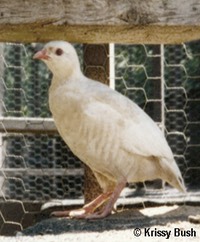• Inbreeding effects two aspects of a population:
1) Fitness:
• What is fitness? It is essentially the survivability and ability to reproduce (pass on their genotype)
• Inbreeding has been shown to have many negative effects on the fitness of birds.
(a) Inbreeding results in an increase in the number of homozygotes. Since the heterozygous condition is thought to be advantageous, the increase in homozygous loci reduces fitness.
(b) An increase in the number of homozygotes can result in the expression of homozygous recessives which may be lethal or severely reduce the fitness of an affected individual.
• It has been shown that for each 10% or 0.1 increase in F (the coefficient of inbreeding), hatchability can decrease by approximately 2-10% depending on the species studied!
• What exactly is
the inbreeding coefficient (F)?
It is the probablity that 2 alleles are identical by descent and not by chance.
2) Genetic:
• Inbreeding can result in an increase in the occurrence of homozygotes or a decrease in heterozygosity. This can decrease the fitness of the population.
• Inbreeding has been shown to have a number of detrimental effects on populations and individuals in captivity. The classic signs of inbreeding in birds are infertility, mental retardation, physical birth defects, an increase in homozygous recessive traits (genetic disorders and colour mutations), death of the chicks while they are still in the egg, death of the chicks shortly after they hatch, weak chicks, and growth retarded birds.
References
• Cooke, F. and Buckley, P.A. 1987. Avian Genetics A Population and Ecological Approach. Academic Press. Chapter 6.
• Griffiths, A. J. F., Miller, J. H., Suzuki, D. T., Lewontin, R. C., and Gelbart, W. M. 1996. An Introduction to Genetic Analysis Sixth Edition. W.H. Freeman and company. New York.
Measuring Inbreeding
Ways to Measure Inbreeding:
1) Genealogies - using pedigrees to measure the level of inbreeding. Based on 2 assumptions: (1) New individuals in a given area are immigrants and unrelated to the birds in the test area & (2) The male feeding and taking care of the young is the father.
2) Biochemical - using genetic markers (microsatellites, allozymes, etc.) to detect genetic variation in a population. Only provides an indirect measure of inbreeding.
• Coefficient of Inbreeding (F) - can be calculated after a population has been studied in enough detail to determine the number of cases of nbreeding relative to the number of cases of outbreeding.
F = (na1 + na2 + na3 .....)/N
"a1 , a2 , a3" = measures of the coefficient of inbreeding
e.g. coefficient of kinship for the following:
father-daughter, mother-son, & brother-sister = 0.25
uncle-niece & aunt-nephew = 0.125
second cousin-second cousin = 0.0156
"n" = the # inbred pairs of each coefficient of inbreeding
"N" = total # of pairs in the study
Example: 250 pairings (N) with 5 cases of inbreeding (2
brother-sister, 2 half brother - half sister, & 1 second cousin -
second cousin) F = (na1 + na2 + na3 .....)/N
F = ([2 x 0.25] + [2 x 0.125] + [1 x 0.0156])/250
F = (0.5 + 0.25 + 0.0156)/250 = 0.7656/250 = 0.00306
When F = 0, there is completely random mating & when F = 1, all of the alleles in the population are identical (due to inbreeding)
References
Cooke, F. and Buckley, P.A. 1987. Avian Genetics A Population and Ecological Approach. Academic Press. Chapter 6.
